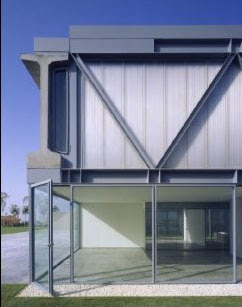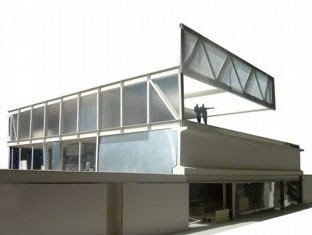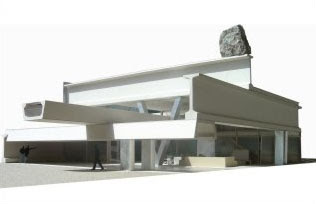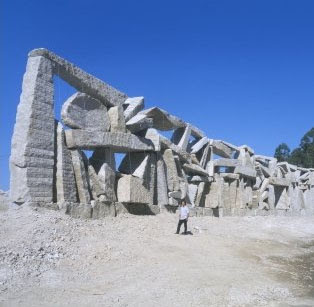 Although I rarely attend architecture lectures due to my familial obligations (and the fact that, aside from pretty slides, the architect's commentary can be mind-numbingly boring) I found myself recently at such an event featuring an up-and-coming star architect from Spain. Anton Garcia-Abril, a gifted designer and builder from Madrid in his late thirties, is relatively young in his profession given his growing reputation. Like most emerging and talented architects in Europe, Garcia-Abril successfully won state-sponsored competitions to establish his practice. He presented a few of those seminal projects in addition to a couple of oversized houses for his family (it always helps to come from an extremely well-heeled family, and many of the most successful architects-especially outside the U.S.-come from the upper class).
Although I rarely attend architecture lectures due to my familial obligations (and the fact that, aside from pretty slides, the architect's commentary can be mind-numbingly boring) I found myself recently at such an event featuring an up-and-coming star architect from Spain. Anton Garcia-Abril, a gifted designer and builder from Madrid in his late thirties, is relatively young in his profession given his growing reputation. Like most emerging and talented architects in Europe, Garcia-Abril successfully won state-sponsored competitions to establish his practice. He presented a few of those seminal projects in addition to a couple of oversized houses for his family (it always helps to come from an extremely well-heeled family, and many of the most successful architects-especially outside the U.S.-come from the upper class).Overall I liked many of the projects he presented, more in the way they conveyed a deep poetic concept than in aspects dealing with efficiency, the quality of spaces and the materials used. His buildings were not to my personal taste, as they displayed too much concrete and the natural stone too contrived in its stonehenge-like roughness. Still, Garcia-Abril has made moving statements about gravity and experimention in structural statics that recall the attempts by Gothic masons to determine how high and how elaborate one could build before inevitable collapse. Structural elements are emphasized by their large scale and minimalist detail, heavy opaque masses appearing to float over vast spaces thanks to delicate connections to the vertical supports. In particular to his houses, Garcia-Abril uses extremely long structural spans to dramatic effect, synthesizing an original structural composition while enabling an interupted flow of spaces and views of the horizons. Some of the projects remind me of Mies Van der Rohe (especially Crown Hall) in the way they celebrate major structural elements and use them as the primary means of architectural expression which effectively dissolves the outer wall envelope, thus allowing unobstructed spatial continuity between inside and outside.
Yet it's that juxtaposition between massiveness and em
 ptiness through the ambitious use of structure which makes his work a target of criticism. At the end of the lecture, a member of the audience posed a question regarding the ethical dilemma resulting from such a style of building. In summary, the question asked: Given the evident amount of construction resources required to make these buildings and the enormous size of the structural members used in building a private house (there were two building cranes on site for one of these houses that erected one story-wide steel girders and precast concrete I-beams more commonly used for highway overpasses), how can the designer ethically justify this approach in a world where the issue of sustainable practice is paramount? The amount of stone, concrete and steel is excessive considering the program of the projects involved, and the required manpower and equipment required to construct such buildings can more commonly be found for commercial sites or grand public works projects than for somebody's private house. There is little to quibble about homes showing off their luxuriousness by the copious use of expensively elegant finishes, but what does it mean when luxury is instead expressed by a complex and energy-intensive construction process?
ptiness through the ambitious use of structure which makes his work a target of criticism. At the end of the lecture, a member of the audience posed a question regarding the ethical dilemma resulting from such a style of building. In summary, the question asked: Given the evident amount of construction resources required to make these buildings and the enormous size of the structural members used in building a private house (there were two building cranes on site for one of these houses that erected one story-wide steel girders and precast concrete I-beams more commonly used for highway overpasses), how can the designer ethically justify this approach in a world where the issue of sustainable practice is paramount? The amount of stone, concrete and steel is excessive considering the program of the projects involved, and the required manpower and equipment required to construct such buildings can more commonly be found for commercial sites or grand public works projects than for somebody's private house. There is little to quibble about homes showing off their luxuriousness by the copious use of expensively elegant finishes, but what does it mean when luxury is instead expressed by a complex and energy-intensive construction process?Garcia-Abril is actually in keeping with the traditional way in which Modernist architecture conveys elegance through the exhibition of technical detailing. Under the Modernism, the rejection of surface ornamentation would be compensated by expert architectural detailing that required a high level of precise craftsmanship and engineering ("God is the Details"-Mies Van der Rohe). Garcia-Abril takes this practice one step further, adding overscaled proportions and an archaic use of 'heaviness'. There is a gradual abandonment of the machine-inspired ideals of the lightness and the efficient use of strong industrial materials that informs the theories and works of the original Modernist founders. Instead, modern is mixed with the primitive to make a statement about basic natural forces and the passage of time by the most unmachine-like of means.
I will confess to sensing a bit of unease while looking at Garcia-
 Abril's house projects for the first time. My response was driven by how such overscaled construction contrasted with the principles of modest proportion, simplicity and cost-effectiveness I personally cherish. Even though such principles are commonly professed by many architects, they do not apply to all architecture nor should they be the sole basis on which to judge projects. There are countless objectives to achieve when designing a building, and each makes a choice as to which of these objectives is worth their while.
Abril's house projects for the first time. My response was driven by how such overscaled construction contrasted with the principles of modest proportion, simplicity and cost-effectiveness I personally cherish. Even though such principles are commonly professed by many architects, they do not apply to all architecture nor should they be the sole basis on which to judge projects. There are countless objectives to achieve when designing a building, and each makes a choice as to which of these objectives is worth their while.To rephrase Garcia-Abril's response to the audience member's question on whether his architecture posed a moral dilemma: "Some architects are excellent theorists and writers but often produce terrible buildings, while others never write a sentence yet produce sublime works of art. I choose to believe that it is better to let the architecture speak for itself, independent of any theoretical or philosophical justification. In the end there is just a building, and whatever verbal rhetoric that accompanied it will eventually be forgotten." I'm sure the Spaniard would somewhat object to my interpretation of what he was trying to say in a foreign tongue that evening, but what I do recall still deeply affects my view of the matter. To be honest, I admire the fact that he refused to directly engage the question by arguing that his designs are sustainable and green depending on the criteria used. And he refused to publicly claim that he was fully committed to sustainability (though he might be), since his work showed quite a few contradictions such a statement (unlike numerous hyprocrite designers who do exactly that). Rather, Garcia-Abril's retort transcended such mundane eco-talk by essentially saying - "Here are my buildings, here is what the design process is like for me, make what you will of it, since in the end its about the building itself and it is independent of any contemporary value system".
 Whether or not that was what Garcia-Abril meant to say, I sympathize with the idea that architecture should not be limited by an overreaching ethical system. What concerns me about the ubiquitous rise of enviromentalism and green sustainability in my profession is how it actively seeks to become the foundation of all ethical decisions about buildings The primary question ceases to become whether a building is beautiful or sublime, but whether it is good for the planet. Such thinking naturally limits a designer's freedom to create, since the environment's needs overpower an individual's need for self-expression. By evaluating new designs from a strictly green perspective, I find that many boring buildings are held up as icons worth emulating for the simple reason that they employ a green-friendly technology that barely can be noticed in the pictures. In my view, the planning of buildings is a uniquely human activity, a combination of problem-solving and art, a tension between the technical and thoughtful composition. Sustainability in design seems to focus on the former aspect, but it has very little new to add to large body of theory dealing with architectural composition. It does not help in examining the problem of expressing tectonic loads in a meaningful way, or in giving a personal character to a wall.
Whether or not that was what Garcia-Abril meant to say, I sympathize with the idea that architecture should not be limited by an overreaching ethical system. What concerns me about the ubiquitous rise of enviromentalism and green sustainability in my profession is how it actively seeks to become the foundation of all ethical decisions about buildings The primary question ceases to become whether a building is beautiful or sublime, but whether it is good for the planet. Such thinking naturally limits a designer's freedom to create, since the environment's needs overpower an individual's need for self-expression. By evaluating new designs from a strictly green perspective, I find that many boring buildings are held up as icons worth emulating for the simple reason that they employ a green-friendly technology that barely can be noticed in the pictures. In my view, the planning of buildings is a uniquely human activity, a combination of problem-solving and art, a tension between the technical and thoughtful composition. Sustainability in design seems to focus on the former aspect, but it has very little new to add to large body of theory dealing with architectural composition. It does not help in examining the problem of expressing tectonic loads in a meaningful way, or in giving a personal character to a wall.What the ethos of sustainability does is add an additional layer of values and codes onto a project. It might improve the way a building performs as a "machine a habiter" (machine for living in) through its stress on efficiency and low environmental impact, but it may sometimes run counter to architecture's role in producing "machines a emouvoir" (machines that move you). For all of some star designer's liberal use of resources to make a unique and dramatic statement, if the building manages to stir the soul then no ethical system, wether secular technocratic modernism of the twentieth century or environmentalism of the twenty-first century, should limit its power.

No comments:
Post a Comment